| Columns Retired Columns & Blogs |
..do two 5.5" drivers go that low? The low frequency harmonic distortion must be extremely high when the speakers are played loud.
I used DRA Labs' MLSSA system and a calibrated DPA 4006 microphone to measure the Vivid Giya G3's frequency response in the farfield, and an Earthworks QTC-40 for the nearfield and spatially averaged room responses. The G3 is specified as having a voltage sensitivity of 87dB/2.83V/m; my estimate was slightly lower than this, at 86dB(B). How the Giya G3's impedance magnitude and electrical phase angle vary with frequency is shown in fig.1. The impedance drops below 6 ohms only in the bass, otherwise remaining above 4 ohms, as specified. There is a current-hungry combination of –40° phase angle and 5.2 ohms at 25Hz; though music rarely has high energy in this region, and the speaker's impedance in the midrange and treble is very high, a good, 4 ohm–rated amplifier should be optimal for driving the G3. The G3's high-frequency impedance is higher than that of the Giya G1, which uses the same drive-units (see fig.1 here), perhaps because the drivers are resistively padded down to match the lower sensitivity of the G3's woofers.
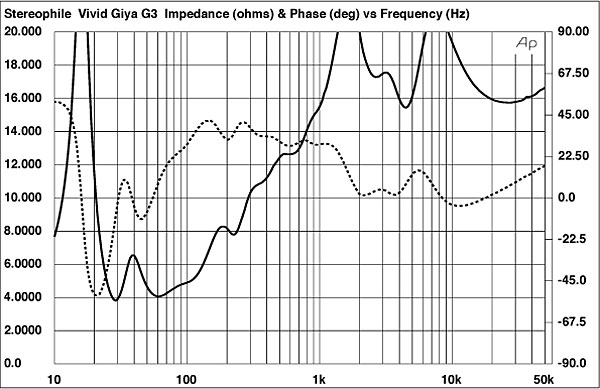
Though there are no discontinuities in the impedance traces (other than one at 37kHz, probably due to the first breakup mode of the tweeter's aluminum dome), there is some unevenness. However, when I investigated the enclosure's vibrational behavior with a plastic-tape accelerometer, I could find no resonant modes. Listening to the various enclosure surfaces with a stethoscope confirmed that the enclosure was, in general, very dead, if slightly less so between 300 and 400Hz in a small region toward the speaker's spine, just below where the coiled and tapered tube reenters the body.
Fig.2 shows the individual responses of the HF/MF drivers (blue trace), the woofers (green), and the ports (red), the nearfield levels scaled in the ratio of the square roots of the radiating areas. The upper-frequency farfield response on the tweeter axis is superbly flat, with small peaks balanced by small dips and a slight rolloff above 20kHz. The lower-midrange unit's output rolls off steeply below the specified crossover point of 220Hz. A couple of midrange peaks are evident in the woofers' upper-frequency output, but the crossover suppresses these by 20dB or more. The minimum-motion notch in the woofers' low-frequency output lies at 29Hz, as suggested by the impedance-magnitude trace in fig.1, but is less well defined than usual for a reflex design. The output of the ports, however, shows a classic bandpass response that peaks at the same 29Hz and, commendably, contains no midrange peaks.
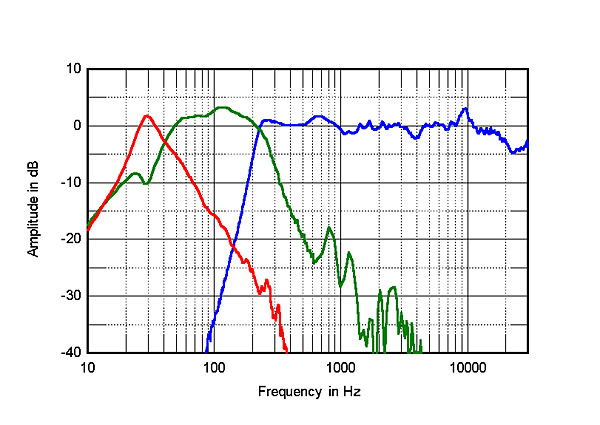
The G3's farfield response, averaged across a 30° horizontal window centered on the tweeter axis, is shown to the right-hand side of fig.3, spliced at 300Hz to the complex sum of the nearfield responses from fig.2, and taking into account both acoustical phase and the drivers' various distances from a nominal farfield microphone position. Again, the upper-frequency output is impressively even, though overall, the treble appears to be balanced between 1 and 2dB lower than the average level in the midrange. This could be because there appears to be a slight excess of energy in the two lower crossover regions.
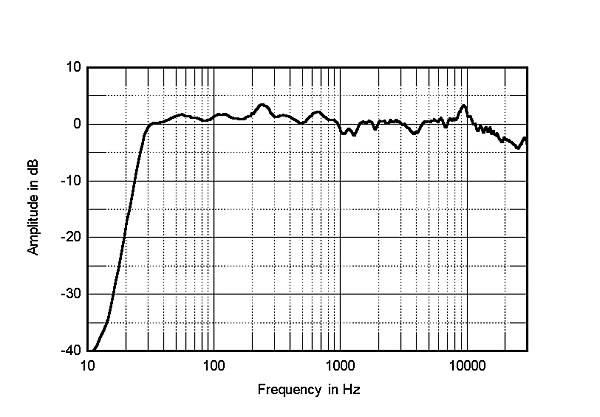
The traces in fig.2 do suggest that there is a little too much overlap between the woofers at the top of their passband and the lower-midrange unit at the bottom of its passband. I plotted these traces at the theoretically correct levels, but they might also have been affected by the assumptions one makes when measuring a speaker in the nearfield. The small, narrow peak just below 10kHz in figs. 2 and 3 is also present in my measured responses of Vivid's Oval B1 and Giya G1; it must be a characteristic of Vivid's T26 tweeter and its acoustic environment. However, I heard nothing wrong in this region. It is also worth noting that the responses of the two G3 speakers matched to within 0.5dB above 1kHz, and within even less than that above 10kHz. The G3's low frequencies appear to extend at full level down to the port tuning frequency, with then a steep rolloff.
With its narrow, tapering front baffle and its use of three closely spaced drive-units to cover the range from 220Hz up, it comes as no surprise that the Giya G3's horizontal dispersion is generally wide, uniform, and even (fig.4). However, like the Giya G1, the G3's dispersion shelves down a little to the speaker's sides above the cursor position at 7kHz, which will make its tonal balance rather mellow in a large room. In the vertical plane (fig.5), the G3 appears to be relatively uncritical of exact listening axis, which is somewhat at odds with my listening experience. But at 15° above the tweeter axis (top trace), a suckout is evident at the upper crossover frequency of 3.7kHz.
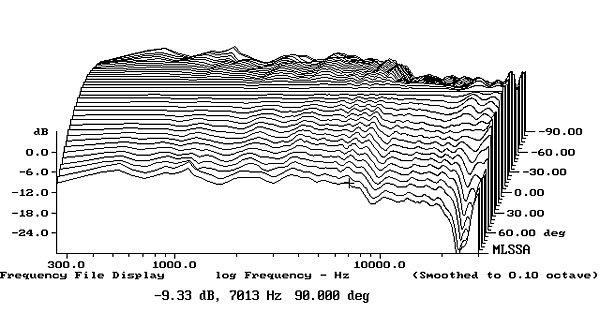
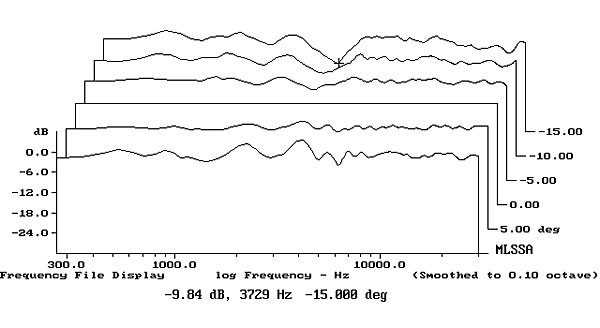
The red trace in fig.6 shows the spatially averaged response of the Giya G3s in my listening room. (The trace was generated by averaging 20 1/6-octave–smoothed spectra, taken for the left and right speakers individually using SMUGSoftware's FuzzMeasure 3.0 program and a 96kHz sample rate, in a vertical rectangular grid 36" wide by 18" high and centered on the positions of my ears.) For reference, the blue trace in this graph is the spatially averaged response of the Wilson Alexia speakers that I reviewed in December 2013. The Wilsons show a little more low-treble energy, but the behavior of the two speakers in-room above 1kHz is otherwise surprisingly similar. The Vivids have a more prominent midrange, and while the two speakers' bass regions are both evenly balanced, the coincidence of the G3's port tuning frequency with the frequency of the diagonal resonant mode in my room results in a huge boost below 40Hz, with a steep rolloff below 25Hz. No wonder I found the Vivid's low bass overripe.
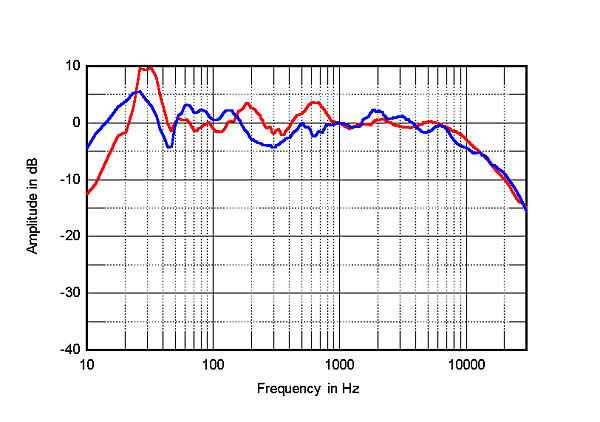
Turning to the time domain, the Giya G3's step response on the tweeter axis is shown in fig.7. This graph indicates that all five drive-units are connected with positive acoustic polarity and that the tweeter's output arrives first at the microphone, followed by the upper-midrange unit's, then the lower-midrange unit's, and then the woofers'. Most important, the decay of each unit's step blends smoothly with the start of the next step lower in frequency, which correlates with the excellent frequency-domain blending of their outputs shown earlier. The cumulative spectral-decay plot (fig.8) has a clean initial decay in the treble, but with some low-level delayed energy.
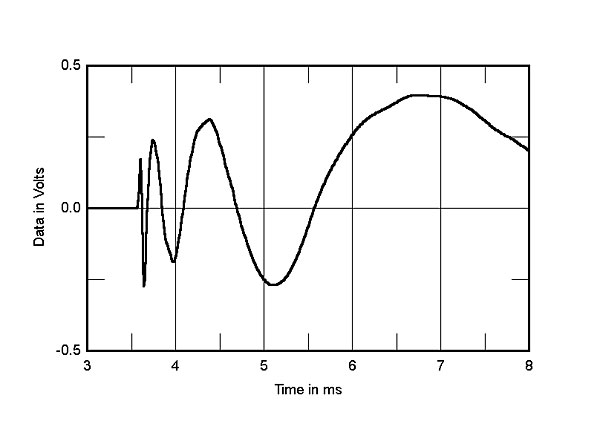
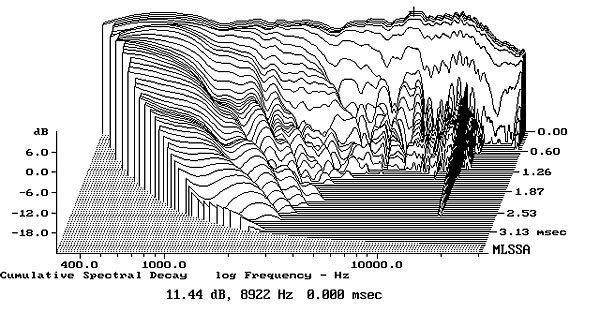
Overall, Vivid's Giya G3 demonstrates impressively good measured performance.—John Atkinson

..do two 5.5" drivers go that low? The low frequency harmonic distortion must be extremely high when the speakers are played loud.

How the hell do two 5.5" drivers go that low? The low frequency harmonic distortion must be extremely high when the speakers are played loud.
I think these Laurence Dickie-designed drive-units are something special. You will note both that I didn't hear any harmonic distortion on low-frequency warble tones and that the speaker did play very loud without strain in my approximately 26' by 15' room.
John Atkinson
Editor, Stereophile

If the G3's can do that, then they really must be something special..(But I can't imagine the motors being anything more than downsized versions of the G1 woofer motors.)

Dear Remlab - no - the G3 uses exactly the same motor system as the G2 and the G1. Only the cone size is smaller. In fact the G3 is substantially over shoved in its design which gives a particularly precise snap over the original G1 design. The new G1 Spirit has a much larger motor to get a similar snap and kick in the bass that the G3 and G2 have.

Were the Kubala's biwired?
Yes, I used the speakers biwired, which is what the manufacturer recommends.
John Atkinson
Editor, Stereophile